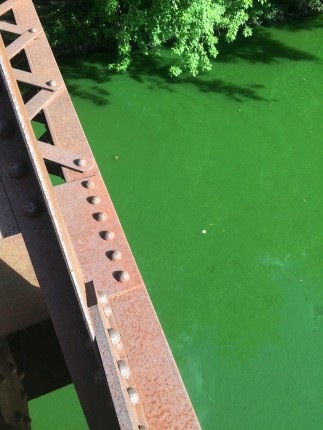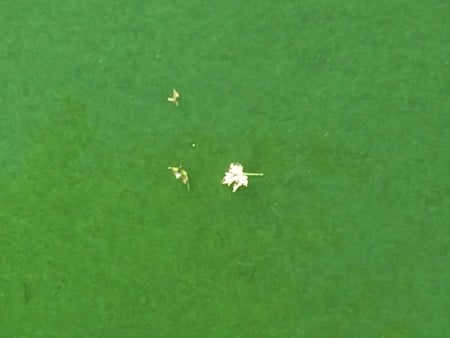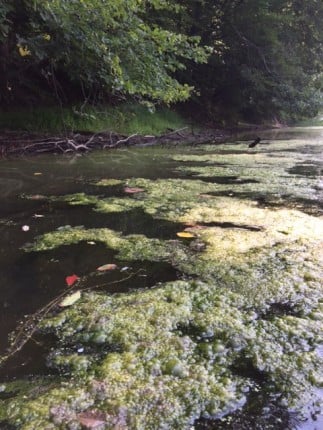Bright Green Algae on Wallkill May be Harmful

Algae photographed north of New Paltz on the Wallkill River on August 26, 2015 (Photo courtesy Rich Picone)
View more images on our Flickr site

Algae photographed north of New Paltz on the Wallkill River on August 26, 2015 (Photo courtesy Rich Picone)
Update Sept 10, 2015: A bright green algal bloom was observed on the Wallkill River at Rosendale. If you can photograph this bloom, please send photos — showing both close-up and extent of the bloom — and note where the photographs were taken. Send photos to [email protected].
Update Sept. 9, 2015: Analysis by Jillian Decker, an algal expert with Rockland Community College and the Wallkill River Watershed Alliance, found two of three cyanobacteria present in a sample collected from the water just after this bloom was observed, suggesting that the algae may indeed have been harmful, posing risk particularly to pets or other animals that might drink the water. (The potentially harmful types of cyanobacteria have multiple strains, some harmful and others not.)
Responding to photographs of bright green algae, including those submitted by members of the Wallkill River Watershed Alliance, the Department of Environmental Conservation has indicated the algal bloom may be blue-green algae that could produce toxins that are harmful to wildlife or fish.
Harmful algal blooms on Lake Erie, expected to reach their largest-ever extent this year, have made headlines and threatened drinking water supplies.
On the Wallkill, conditions are right for algal blooms, given that the Wallkill is known to have an excess of nutrients (from sources such as farm runoff, lawn fertilizers and treated sewage discharges). Those nutrients feed algae during sunny, drought-like conditions, which produce stagnant water, particularly when coupled with dams.
If you see bright green algae such as is pictured here, send information about its extent, and the location observed, along with photos to [email protected].

Algae photographed north of New Paltz on the Wallkill River on August 26, 2015 (Photo courtesy Rich Picone)
We’re also hearing reports of algae on other Hudson River tributaries, including the Esopus Creek. Note that not all algae produces toxins like blue green algae can.
Like the Wallkill, the Esopus has known impacts from nutrients. “Public bathing, recreational uses and aquatic life support in this portion of Esopus Creek are known to experience minor impacts due to nutrient enrichment from urban runoff and agricultural nonpoint sources,” according to the Department of Environmental Conservation’s Waterbody Inventory for the Esopus Creek.
Just the appearance of algae may be a violation of state Water Quality Standards, which state that nutrients should not be present “in amounts that result in the growths of algae, weeds and slimes that will impair the waters for their best usages.” In the case of both the Wallkill and Esopus in the areas photographed here, the best uses of these Class B waters includes swimming, boating and fishing — which would be impaired by the presence of this much algae, whether or not it produces toxins.
The Hudson itself is “the most heavily nutrient-loaded estuary in the world”, with huge inputs dominated by sewage-related sources in the densely populated lower estuary, lawn fertilizer-related inputs in New York City’s near suburbs in the lower Hudson region, by farm fertilizer or a combination of sources in the upper reaches of the estuary, and by the deposition from fossil fuel combustion, according to the research of Robert W. Howarth and Roxanne Marino of Cornell University and others. But unlike the Gulf of Mexico, Chesapeake Bay or other coastal estuaries that suffer from seasonal dead zones related to excess nutrients, the Hudson is generally resistant to the worst consequences of this nutrient overload because it flushes relatively quickly, so the right conditions for algal blooms rarely occur. The risk of impacts from nutrient overload may increase with climate change, if summer droughts drain freshwater from the system, reducing the system’s self-flushing ability.

